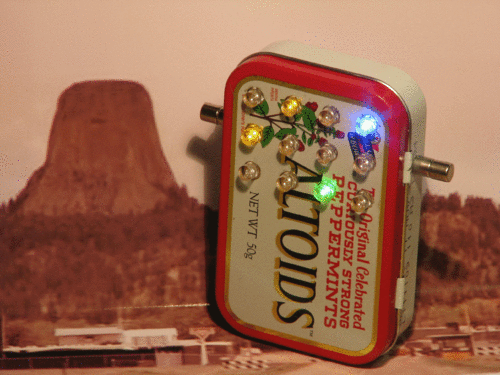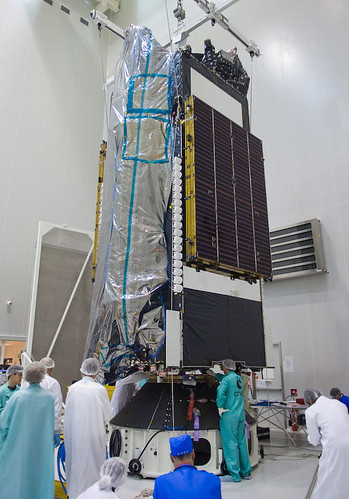Satcom News
Monday, June 15th, 2009Last week’s news summary, courtesy of Bill McDonald:
TeamCast and BBC will partner to develop new DVB-T2 modulator for professional applications.
[Satellite Today – 06/12/2009]
Euroconsult, a French satellite consulting firm, forecasts that nearly 1,200 satellites will be built and launched between 2009 and 1028, and increase of about 50% over previous decade.
[Satellite Today – 06/11/2009]
Intelsat plans launch of 11 satellites by end of 2012, 5 of which will refresh Asia-Pacific fleet.
[CNBC – 06/11/2009]
Thaicom opens gateway in Jakarta, Indonesia, the 15th gateway in the Asia-Pacific region.
[Satellite Today – 06/11/2009]
GOES-O launch date moved back to June 26th so design changes can be incorporated in linear shape charge system of Range Safety command destruct system of Delta IV rocket..
[SatNews – 06/11/2009]
Marlink acquires capacity on Tlesat’s Telstar 11N to extend its WaveCall maritime coverage into the North Atlantic Ocean.
[Satellite Today – 06/11/2009]
Successful 19 month Japanese moon mission concludes with a controlled crash landing on the surface.
{R&D Magazine – 06/11/2009]
MEASAT Satellite Systems and Classica Asia sign 5 year agreement for UNITEL CLASSICA HD channel to be distributed via MEASAT-3 satellite.
[SatNews – 06/11/2009]
C2SAT enters into licensing agreement for Shanghai based Xinguo IT to produce C2SAT stabilized antenna systems in China.
[SatNews – 06/11/2009]
Lockheed Martin team successfully mates infrared sensor payload to spacecraft bus for Air Force’s GEO-2 satellite.
[SatNews – 06/11/2009]
Digi International enters satellite market with acquisition of all assets of all assets of MobiApps Holdings Private Limited, a developer of machine-to-machine communications technology focused on satellite, cellular, and hybrid solutions.
[Satellite Today – 063/11/2009]
Citrix partners with TeleCommunications Systems to support the satellite communication capabilities of the U.S. Army.
[UPI – 06/10/2009]
Iridium is awarded a phase II contract for continued development of the Distributed Tactical Communications System for the U.S. Navy.
[UPI – 06/10/2009]
ILS gets second contract of 2009 from Intelsat for two new firm satellite launches and one optional launch.
[SatNews – 06/10/2009]
Integral Systems signs deal with Orbital Sciences Corp tfor primary and backup satellite command and control systems for Koreasat-6.
[Satellite Today – 06/10/2009]
Satellite manufacturing facility planned for Dubai based on engineering skills learned during Dubai-Sat 1 construction in South Korea.
[Khaleej Times – 06/10/2009]
Spacenet announces Innovation & Technology award to Missouri Department of Transportation for innovative emergency communications satellite solution.
[TMCnet – 06/10/2009]
Cable and satellite TV providers use the digital TV transition today, Friday June 12, to push to add subscribers.
[nvdaily – 06/10/2009]
Univision and Televisa argue before federal judge over rights to stream Televisa’s shows on line and on cell phones in U.S.
[AP – 06/10/2009]
DirecTV VP for government affairs accuses Comcast and other cable companies of pushing Massachusetts legislation for 5% sales tax on satellite DTV service as Satellite Broadcasting and Communications Association launches media offensive against the legislation.
[Boston Herald – 06/10/2009]
Caprock Government Solutions receives Satellite Industry Leadership Award from 2009 International Satellite and Communications exchange conference in San Diego.
[SatNews – 06/09/2009]
TerreStar announces rescheduling of launch of TerreStar-1 for July7-12, 2009 to ensure on-orbit anomaly on another operator’s satellite has no bearing on flight-worthiness of TerreStar-1.
[SatNews – 06/09/2009]
KVH adds dedicated Crew Calling Gateway to mini-VSAT system for Nor-Shipping in Norway.
[SatNews – 09/09/2009]
Air Force formally terminates contracts with companies including Lockheed Martin Corp. for TSAT communications satellite system.
[Forbes – 06/08/2009]
General Dynamics wins $119m U.S. Army WIN-T order for 293 satellite terminals and support services.
[Satellite Today – 06/08/2009]
KCPC Satellite Communications announces offer to purchase shares of Gilat Satellite Communications.
[Business Wire – 06/08/2009]
WildBlue provides hands-on demonstration of "next generation" satellite broadband for consumers on Capitol Hill.
[Business Wire – 06/08/2009]
Eutelsat announces data rate increase of Tooway consumer broadband service from 2 Mbps to 3.6 Mbps at no additional cost.
[PR Newswire – 06/08/2009]
Inflatable tower, built from materials available today, could climb to the edge of space and be used for research, tourism, telecommunications, or launching spacecraft.
[New Scientist – 06/08/2009]
Senator Feinstein expresses "extraordinarily serious concern" over new electro-optical satellites for the DOD recently approved by President Obama.
[got geoint? – 09/10/2009]
WBMSAT PS – Satellite Communications Consulting Services








